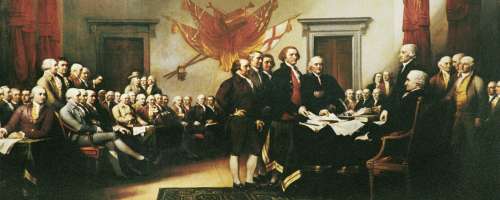 |
Patriot Resource Index
 American Revolution Index
American Revolution Index
 Surveys and Lists
Surveys and Lists
Military Campaigns
Reference Lists
Surveys By Year
-:1763-68: Tensions Rise
-:1768-74: Prelude to War
-:1775: War Begins
-:1776: Independence
-:1777: War Continues
-:1778: War Continues
-:1779: War Continues
-:1780: War Moves South
-:1781: Victory
-:1782-1789/Bibliography
Timeline: 1781
Timeline: 1782
Timeline: 1783
Timeline: 1784-1794
 American Revolution Index
American Revolution Index
 Battles
Battles
 Documents
Documents
 Events
Events
 Landmarks & Places
Landmarks & Places
 People: The Patriots
People: The Patriots
 People: Continental Army
People: Continental Army
 People: British Army
People: British Army
 Timelines
Timelines
 Books
Books
 Multimedia
Multimedia
 Links & Other Resources
Links & Other Resources
Search the Site
Site Map
Contact Us
PatriotResource.com:
Main Index
Film Index
Film: Gladiator
Film: National Treasure
Film: The Patriot
Film: Tombstone
Films: General
Films: Fantasy
Films: SciFi
History: 1775-1781
History: September 11th
Lord of the Rings
NORAM Road Trips
OtherWorld: Index
TV Series: Index
TV: Battlestar Galactica
TV: Caprica
TV: Deadliest Catch
TV: Lost
TV Series: Action
TV Series: Animated
TV: BBC Presentations
TV Series: Comedy
TV Series: Drama
TV: Fantasy/SciFi
TV Series: Western
TV Series: Reviews
Military Campaigns
Reference Lists
Surveys By Year
-:1763-68: Tensions Rise
-:1768-74: Prelude to War
-:1775: War Begins
-:1776: Independence
-:1777: War Continues
-:1778: War Continues
-:1779: War Continues
-:1780: War Moves South
-:1781: Victory
-:1782-1789/Bibliography
Timeline: 1781
Timeline: 1782
Timeline: 1783
Timeline: 1784-1794
Site Map
Contact Us
Main Index
Film Index
Film: Gladiator
Film: National Treasure
Film: The Patriot
Film: Tombstone
Films: General
Films: Fantasy
Films: SciFi
History: 1775-1781
History: September 11th
Lord of the Rings
NORAM Road Trips
OtherWorld: Index
TV Series: Index
TV: Battlestar Galactica
TV: Caprica
TV: Deadliest Catch
TV: Lost
TV Series: Action
TV Series: Animated
TV: BBC Presentations
TV Series: Comedy
TV Series: Drama
TV: Fantasy/SciFi
TV Series: Western
TV Series: Reviews

Meanwhile, in Paris, peace negotiations slowly took place. Finally on September 3, Britian, France, Spain, Holland and the United States signed the Treaty of Paris. On November 25, 1783, New York, which had been held by Maj. General Guy Carleton since 1782, when he replaced Lt. General Henry Clinton as Commander in America, was evacuated by the last British soldier and General George Washington finally took possession of the city. On December 23, George Washington resigned his commission. Finally on January 14, 1784, the Continental Congress ratified the Treaty of Paris.
On May 25, 1787, the Constitutional Congress convened in Philadelphia Pennsylvania with the objective of putting together a unified Constitution to replace the Articles of Confederation. On September 17, 1787, the United States Constitution was signed. nine states then ratified the Constitution over the next several months ending with New Hampshire's ratification on June 21, 1788. Virginia, New York, North Carolina, Rhode Island and Vermont would subsequently ratify the Constitution. On March 4, 1789, the United States officially commenced under its Constitution. On April 30, 1789, George Washington was sworn in as the First President of the United States.


